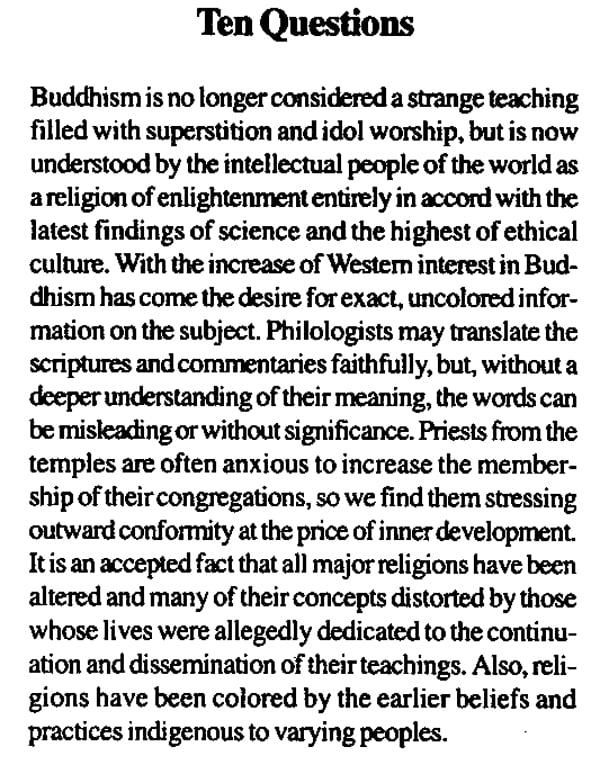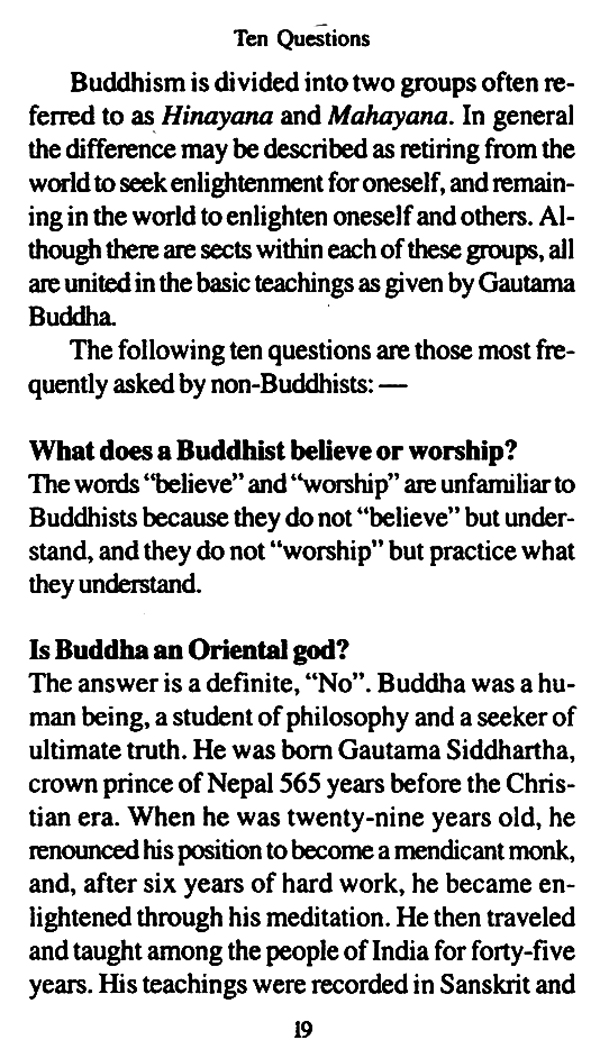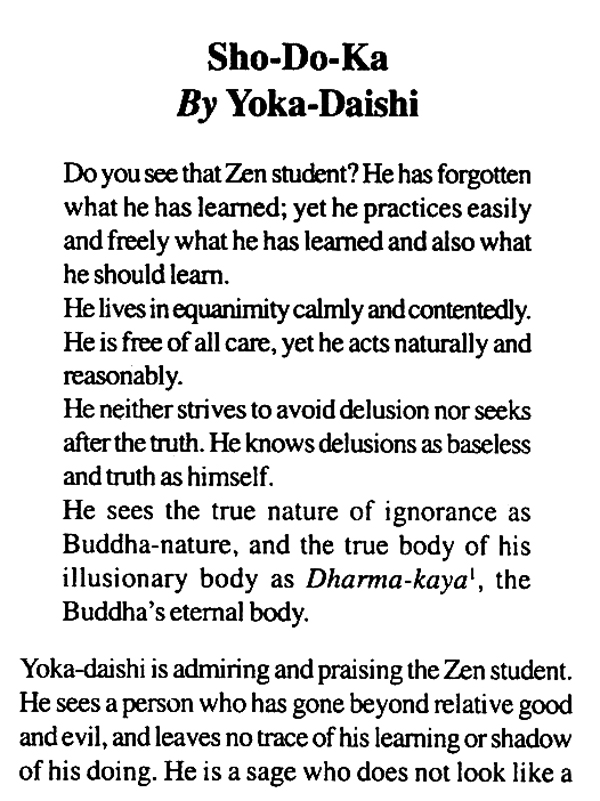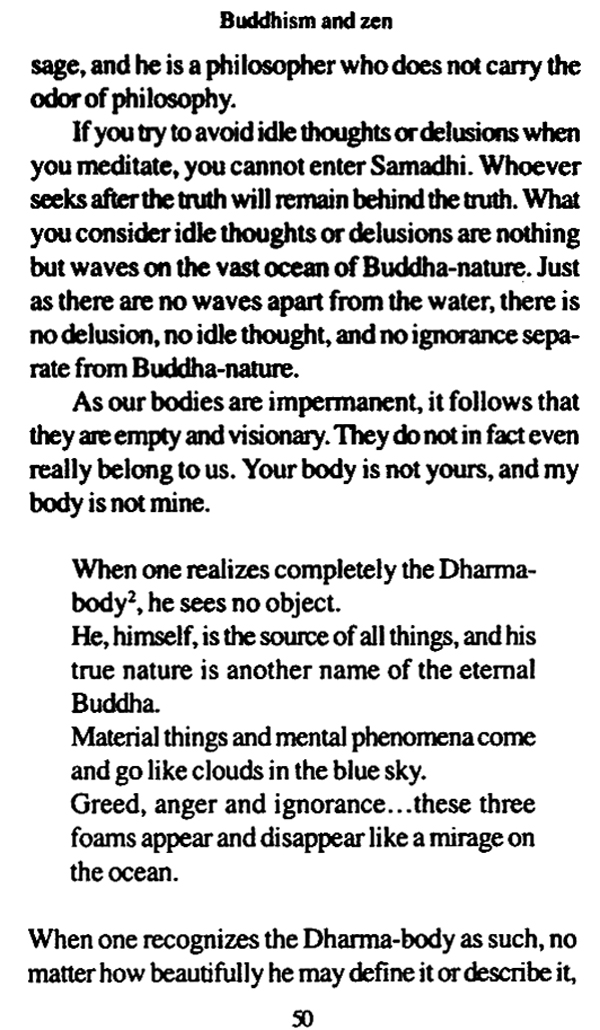
Buddhism and Zen
Book Specification
| Item Code: | NAX731 |
| Author: | Nyogen Senzaki and Ruth Strout McCandless |
| Publisher: | Pilgrims Publishing, Varanasi |
| Language: | English |
| Edition: | 2007 |
| ISBN: | 9788177695816 |
| Pages: | 125 |
| Cover: | PAPERBACK |
| Other Details | 7.00 X 5.00 inch |
| Weight | 100 gm |
Book Description
Buddhism was already established in China when Bodhi-Dharma arrived from India in the sixth century. Monasteries had been built; many of the Sutras' translated, and learned students of Buddhism spent long hours discoursing upon the nuances of the religious and philosophical aspects of its teachings. A thousand years had passed since the Buddha's death. In India the two major schools of Buddhism, the Hinayana and Mahayana2, were developing according to their principles. The Hinayana, or Lesser Vehicle, basing its premise on the Pali texts, clung to the letter of the Sutras without regard for one of Buddha's primary tenets, namely, that all is constant change. The Mahayana, or Greater Vehicle, taught not only the necessity for enlightenment, but also the need to stay in the world to enlighten others. The Hinayanists had kept their school pure, but at the expense of growth, whereas the Mahayanists had grown, but of-ten at the expense of purity of understanding. In both schools Buddhist teachings were sometimes obscured by the earlier beliefs and superstitions of its converts.
Chinese Buddhism was predominantly Mahayana, and, at this date, more concerned with the precepts than with enlightenment. China's own great teachers, Kung-fu-tsu and Lao-tzu, had many adherents. Confucianism was of more popular appeal because it laid down definite rules and regulations to be followed, but Taoism had deep roots among the more Intellectual. When the gradual spread of Buddhism began in China around 200 AD., it found fertile ground in both Confucianism and Taoism. Confucians appreciated Buddhist ethics, and Taoists understood the ultimate aim of Buddhism. As Chinese scholars translated the Sanskrit texts of the Tripitaka3 available to them, they automatically stripped off some of the more fanciful flights of Indian philosophy in favor of the practical approach demanded by their own nature. The Chinese had little use for abstract theory unrelated to practical application.
Bodhi-Dharma, the "Blue-eyed Monk", and twenty-eighth successor of Buddha Sakyamuni,4 had not made the long journey to involve himself in academic discussion nor to curry favor among the famous. When he was brought before the emperor, the emperor recited his own numerous charities, which included the building and endowing of monasteries, and then asked Bodhi-Dharma what credit he had so achieved. Much to the emperor's surprise, Bodhi-Dharma replied: "None whatever."
Those who followed Bodhi-Dharma were young men of great determination dedicated to complete enlightenment. Bodhi-Dharma did not encourage them, but when they had proved their sincerity, he taught them and meditated with them. Hui-k'e was the first in China to receive the "Lamp of Dharma", of which Bodhi-Dharma said:
"A special transmission outside the scriptures; Without dependence on words or letters; Direct pointing to the essence of mind; Seeing one's true nature and attaining Buddhahood."
Bodhi-Dharma foretold that "with five petals the flower would be complete." Succeeding generations produced five outstanding teachers, from whose particular methods five Chinese Zen schools were evolved continuing the teaching and transmitting the Dharma.
These schools were known as the Dhyana5 or meditation schools. Ch' an, the Chinese equivalent of Dhyana, became Zen when introduced in Japan in the twelfth century. Japanese scholars wrote the first books in English on the subject, and it is for this reason that the Western world now uses the word Zen in its religio-philosophical vocabulary. Zen originally meant meditation, but it came to mean also enlightenment, the means of enlightenment, concentration of mind, and even certain qualities for which Zen fol-lowers became noted.
The teachings of the Sixth Patriarch, Wei Lang (Huineng, Eno or Yeno), were gathered into a Sutra becoming known as the Chinese Sutra, the only one outside the translated portions of the Tripitaka. This Sutra is based on Buddhism, but it is interesting to note that early writers seldom mentioned Zen or even Buddhism by name, writing only of principles and practice.
Zen grew out of Buddhism and Taoism, and has for centuries been a distinct, unique form of Buddhism. Zen does not claim that only those of Buddhist back-ground and training can achieve its realization. When Meister Eckhart asserted: "The eye with which I see God is the same eye with which God sees me," Zen nodded its agreement. It willingly accepts all that is true in any religion and recognizes those of any faith who have gained complete realization; however, it knows that despite great sincerity a person, whose religious training is based on dualism, will have an unnecessarily difficult time before gaining enlightenment. Zen brushes aside anything, no matter of what seeming triviality, that does not deal directly with reality, nor will it countenance anything less than an individual's own experience.
**Sample Pages**










